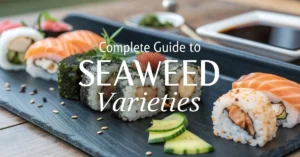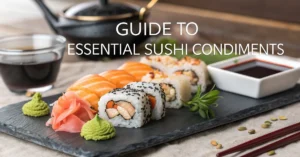Craving that authentic sushi experience at home? It all begins with the perfect bowl of rice. More than just a side dish, japanese rice is the foundation of countless Japanese dishes. Choosing the right brand can make all the difference between a decent meal and a truly exceptional culinary experience. Navigating the world of premium Japanese rice brands might seem daunting. So many options line the shelves, each promising superior taste and texture. But with a little guidance, you can unlock the secrets to selecting the perfect grain for your next culinary adventure.
Guide to Premium Japanese Rice Brands
Why Japanese Rice Stands Apart
What sets japanese rice apart from other varieties? It boils down to several key factors, from genetics to growing practices.
Short-Grain Superiority: Japanese rice is typically short-grain, characterized by its plump, round shape. This unique structure contributes to its distinctive stickiness when cooked, allowing the grains to cling together without becoming mushy. This is essential for sushi, where the rice needs to hold its shape.
Amylose Content is Key: The level of amylose, a type of starch, also plays a role. Japanese rice generally has a lower amylose content than long-grain varieties. This lower amylose contributes to its characteristic stickiness and slightly sweet flavor.
Careful Cultivation: Japanese rice farmers have honed their techniques over centuries. They prioritize meticulous water management, soil health, and pest control. These practices ensure the highest quality grains. The dedication and attention to detail create a product that is both consistent and delicious.
“Shinmai” – The Freshest Crop: In Japan, the term “Shinmai” (新米), meaning “new rice,” refers to the freshly harvested rice of the current year. Shinmai is prized for its superior moisture content and flavor.
Top Japanese Rice Brands to Elevate Your Cooking
Now that you understand the qualities that make japanese rice exceptional, let’s explore some of the top brands available on the market. Each brand offers a unique take on this staple ingredient. They are all known for their quality and commitment to excellence.
1. Tamanishiki
A Hybrid of Tradition and Innovation: Tamanishiki is a premium brand created through a cross between Yamada Nishiki (a sake rice) and Koshihikari (a table rice). This careful hybridization yields a grain that is both flavorful and versatile. It is a favorite among chefs and home cooks alike.
Flavor Profile: It offers a subtle sweetness and a pleasant aroma. These qualities make it ideal for a wide range of dishes. Tamanishiki rice cooks up fluffy but still retains a desirable chewiness. This texture provides a satisfying mouthfeel.
Culinary Versatility: From sushi rolls to onigiri (rice balls) and simple steamed rice dishes, Tamanishiki shines in every application. Its balanced flavor complements both delicate and bold flavors.
Availability: This brand is widely available in Asian supermarkets and online retailers, making it a convenient choice for many.
2. Koshihikari
The Gold Standard: Koshihikari is perhaps the most well-known and widely consumed japanese rice variety. It is considered by many to be the gold standard for its exceptional flavor, texture, and aroma.
Flavor Profile: It boasts a naturally sweet taste and a delicate fragrance that fills the kitchen as it cooks. The cooked grains are soft, plump, and slightly sticky.
Ideal for Sushi: Its excellent texture and ability to absorb flavors make it a top choice for sushi. The rice holds its shape well, creating perfect sushi rolls and nigiri.
Growing Regions: Koshihikari is grown in various regions of Japan. The most prized crops come from Niigata Prefecture, known for its pristine water and fertile soil.
A Household Name: You can find Koshihikari in most Japanese grocery stores and many well-stocked supermarkets.
3. Yume Gokochi
“Dream Comfort” in a Bowl: Yume Gokochi translates to “dream comfort,” which perfectly captures the eating experience. This variety is gaining popularity for its exceptional qualities.
Flavor Profile: Yume Gokochi offers a rich, creamy flavor and a soft, almost melt-in-your-mouth texture. It is slightly stickier than Koshihikari. It’s an excellent rice for those who love the glutinous rice experience.
Unique Characteristics: The grains are known for their luster and uniform size. This consistency contributes to a visually appealing and satisfying dish.
Best Uses: While versatile, Yume Gokochi is particularly well-suited for dishes where the rice is the star. Think rice bowls (donburi) and simple steamed rice served with flavorful toppings.
Growing Practices: This variety is typically grown with a focus on sustainable and environmentally friendly practices.
4. Akita Komachi
Named After a Beauty: Akita Komachi is named after a famous Japanese beauty from the Akita Prefecture. This variety is known for its elegance and refined flavor.
Flavor Profile: This rice boasts a clean, delicate taste and a slightly firm texture. It is not as sticky as Koshihikari or Yume Gokochi. This offers a pleasant alternative for those who prefer a less sticky rice.
A Versatile Choice: Akita Komachi is an excellent all-purpose rice. This makes it suitable for everyday meals, bento boxes, and sushi.
Affordability: It is generally more affordable than some of the other premium brands. It makes it a great option for budget-conscious consumers.
Growing Region: As the name suggests, Akita Komachi is primarily grown in the Akita Prefecture of Japan. This area contributes to the rice’s unique characteristics.
5. Kinmemai Premium
The Polishing Revolution: Kinmemai Premium is not a specific rice variety but rather a unique polishing process. This innovative process retains more of the nutritious sub-aleurone layer of the rice grain. This creates a healthier and more flavorful product.
Flavor Profile: The rice has a rich, nutty flavor and a slightly sweet taste. The texture is soft and fluffy. It holds its shape well.
Nutritional Benefits: Kinmemai Premium boasts higher levels of vitamins, minerals, and dietary fiber. This makes it a nutritious choice.
Cooking Time: It requires a shorter cooking time than regular white rice. This is a bonus for busy cooks.
A Modern Approach: Kinmemai Premium represents a modern approach to rice production. It combines traditional techniques with innovative technology.
6. Hitomebore
“Love at First Sight”: Hitomebore translates to “love at first sight.” This promises a delightful culinary experience from the moment you see the cooked grains.
Flavor Profile: It has a balanced flavor profile. It’s not overly sweet or starchy, which is suitable for many dishes. The texture is firm but tender.
A Good All-Rounder: This variety is a reliable choice for everyday cooking. Think rice bowls, stir-fries, and as a side dish to grilled meats or fish.
Growing Region: Hitomebore is primarily grown in the northern regions of Japan, where the cool climate contributes to its unique qualities.
Consistency: This variety is known for its consistent quality and reliable performance.
Finding the Perfect Rice for Your Needs
With so many excellent options available, how do you choose the best japanese rice for your needs? Here are some factors to consider:
- Intended Use: Are you planning to make sushi? Or are you looking for an everyday rice for simple meals? Stickier varieties like Koshihikari are ideal for sushi. Less sticky varieties like Akita Komachi are great for everyday use.
- Flavor Preference: Do you prefer a sweeter rice or one with a more subtle flavor? Consider the flavor profiles described above to match your palate.
- Budget: Premium japanese rice can be more expensive than other varieties. Consider your budget when making your selection. Akita Komachi is a more affordable option.
- Availability: Some brands may be more difficult to find than others. Check your local Asian supermarkets and online retailers.
- Nutritional Needs: If you are looking for a rice with enhanced nutritional benefits, Kinmemai Premium is a great choice.
Essential Tips for Cooking Japanese Rice
Once you’ve chosen your premium japanese rice, follow these tips to ensure a perfect bowl every time:
- Rinse Thoroughly: Rinse the rice under cold water several times until the water runs clear. This removes excess starch and prevents the rice from becoming gummy.
- Use the Right Water Ratio: A general rule of thumb is to use a 1:1.25 ratio of rice to water. Adjust slightly depending on your preference and the variety of rice.
- Soak Before Cooking: Soaking the rice for 30 minutes before cooking allows the grains to absorb water evenly. This results in a more tender and evenly cooked texture.
- Cook with Care: Use a rice cooker for best results. If cooking on the stovetop, bring the rice to a boil, then reduce the heat to low. Simmer covered for 15-20 minutes, or until all the water is absorbed.
- Steam After Cooking: After cooking, let the rice steam covered for 10-15 minutes. This allows the moisture to redistribute, resulting in a fluffier texture.
- Fluff Gently: Use a rice paddle (shamoji) to gently fluff the rice before serving. Avoid stirring vigorously, as this can break the grains.
Beyond the Grain: Storing Your Japanese Rice
Proper storage is essential to maintain the quality and freshness of your japanese rice. Here are some tips:
- Airtight Container: Transfer the rice to an airtight container after opening the package. This protects it from moisture, pests, and odors.
- Cool, Dark Place: Store the container in a cool, dark place away from direct sunlight and heat.
- Avoid Refrigeration: Refrigeration can dry out the rice and alter its texture.
- Use Within a Reasonable Time: For the best quality, use the rice within a few months of purchase.
- Check for Infestation: Regularly check the rice for any signs of pests or infestation.
Rice Purity: Does Organic Japanese Rice Matter?
As awareness of sustainable practices has grown, the demand for organic japanese rice has increased. Organic rice farming emphasizes natural methods of cultivation, avoiding synthetic pesticides and fertilizers.
Benefits of Organic:
- Reduced Chemical Exposure: Organic rice is grown without synthetic chemicals. This reduces your exposure to potentially harmful substances.
- Environmental Sustainability: Organic farming practices promote soil health, biodiversity, and water conservation.
- Potential Flavor Differences: Some believe that organic rice has a more natural and nuanced flavor due to the healthier soil and growing conditions.
Considerations:
- Price: Organic japanese rice is typically more expensive than conventionally grown varieties.
- Availability: Organic options may be less widely available than conventional brands.
- Certification: Look for reputable organic certifications to ensure the rice meets strict standards.
Whether or not to choose organic japanese rice is a personal decision. Weigh the benefits and considerations to determine what aligns with your values and preferences.
Expanding Your Rice Horizons: Japanese Rice-Based Delights
Japanese rice is incredibly versatile. It can be used in a wide array of dishes beyond sushi and simple steamed rice. Here are a few ideas to inspire your culinary creativity:
- Onigiri (Rice Balls): These portable snacks are perfect for picnics, lunchboxes, or a quick bite. Fill them with your favorite ingredients, such as pickled plums (umeboshi), tuna mayonnaise, or grilled salmon.
- Okayu (Rice Porridge): A comforting and nourishing dish often eaten for breakfast or when feeling under the weather. It is made by simmering rice in plenty of water until it reaches a creamy consistency.
- Chahan (Fried Rice): A flavorful and satisfying dish made by stir-frying cooked rice with vegetables, meat, and seasonings.
- Donburi (Rice Bowls): A popular and customizable dish consisting of a bowl of rice topped with various ingredients, such as beef (gyudon), chicken and egg (oyakodon), or tempura (tendon).
- Mochi (Rice Cakes): A traditional Japanese confection made from pounded glutinous rice. It is often eaten during special occasions and festivals.
Savoring Simplicity: The Art of Appreciation
Ultimately, the best japanese rice is the one that you enjoy the most. Experiment with different brands, varieties, and cooking methods to discover your personal preference. Take the time to savor the subtle nuances in flavor and texture. Recognize the dedication and skill that goes into producing this exceptional grain. In doing so, you will deepen your appreciation for Japanese cuisine and culture. Your rice bowl will be a world-class culinary experience.



